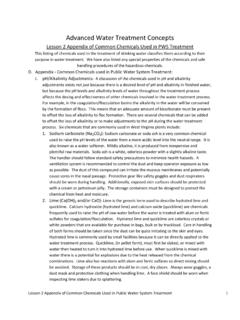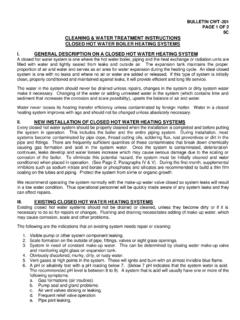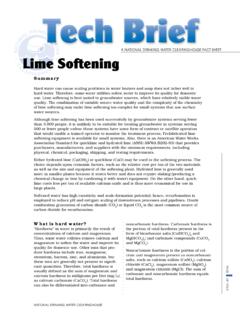Transcription of Treatment of Sulphate in Mine Effluents - INAP
1 Treatment of Sulphatein Mine EffluentsOctober 2003 LORAXENVIRONMENTAL EXECUTIVE SUMMARY i Executive Summary In the Treatment of Acid Rock Drainage (ARD) little attention has focused on the mitigation of dissolved Sulphate ; this may be attributed to its lower environmental risks and regulatory standards when compared to those for acidity and dissolved metals. However, regulatory agencies are becoming increasingly concerned over elevated Sulphate concentrations in Effluents owing largely to its impact to the salinity of receiving waters. This concern will like result in more stringent regulatory standards for Sulphate in effluent such that Sulphate Treatment becomes necessary. Although Sulphate Treatment is currently under investigation and in many cases in practice, comparatively little information has been documented. In light of this, the International Network for Acid Prevention (INAP) has decided to investigate the current state of the art of Sulphate Treatment .
2 The primary objective of this review is to present an overview of the current state of the art Treatment processes to reduce Sulphate (with or without dissolved metals) in mine Effluents . The organization and sharing of knowledge on such processes will hopefully guide future developments in reducing dissolved Sulphate in ARD. The consumption of drinking water containing Sulphate concentrations in excess of 600 mg/L commonly results in laxative effects. The taste threshold for the most prevalent Sulphate salts ranges from 250 to 500 mg/L. While the World Health Organization (WHO) does not propose a health-based guideline for Sulphate in drinking water, it does recommend that health authorities are notified if Sulphate concentrations exceed 500 mg/L. Accordingly, most countries in the world recommend a drinking water standard for Sulphate between 250 and 500 mg/L.
3 After a review of the available information, several Treatment processes were selected for review. The selection criteria for each process were based on: (1) applicability to Sulphate removal and (2) availability of data on Sulphate removal and costs. The Treatment processes meeting these criteria were organized into 4 categories: (1) chemical Treatment with mineral precipitation; (2) membranes; (3) ion-exchange; and, (4) biological Sulphate removal. The selected Sulphate Treatment processes are well-documented and often tested in (pilot) plants or large field-trials. For many of the selected Treatment processes at least some estimate of the capital and/or operational costs are available. Several other ARD Treatment processes are not included in this review because they cannot be used for the removal of Sulphate from ARD. Treatment processes that represent chemical ammendments with mineral precipitation are: (1) lime or limestone addition, (2) addition of barium salts, (3) the SAVMIN process and (4) the EXECUTIVE SUMMARY Sulphate Treatment TECHNOLOGIES ii Inap LORAX cost-effective Sulphate removal (CESR) process.
4 Membrane technology include: (1) Reverse Osmosis (RO), (2) the SPARRO process and (3) Electrical Dialysis Reversal (EDR), while ion-exchange technologies include: (1) the GYP-CIX process and (2) Metal Precipitation and Ion-Exchange (GYP-CIX). The Sulphate Treatment processes that incorporate biological Sulphate removal include: (1) Bioreactors, (2) Constructed Wetlands, (3) Alkalinity Producing Systems, and (4) Permeable Reactive Barriers. The most important characteristics of the Sulphate Treatment processes used in the case studies are summarized in Table I to Table III for the different types of Treatment technology. When comparing costs of the different Treatment processes it should be noted that: (1) estimated costs depend strongly on the specific process design, local market prices and local labour costs; (2) cost estimates are time-sensitive and have not been normalized to present day cost.
5 Accordingly, the reported capital and operating costs should be used with caution. Among the processes that use chemical Treatment with mineral precipitation (Table I), the limestone/lime and SAVMIN processes appear to be the most suitable for Sulphate removal from mine water. Although the limestone/lime process can only reduce Sulphate concentrations to 1200 mg/L, it is inexpensive and therefore useful as a pretreatment process for other, more expensive Treatment systems. The more expensive SAVMIN process, can reduce Sulphate concentrations to very low levels. Both processes also remove (trace) metals from mine water. The BaS and CESR processes are probably the most expensive and the CESR process produces the largest amount of sludge. Compared to other types of Treatment technology (Table II and Table III), chemical Treatment processes with mineral precipitation produce the largest amount of sludge.
6 Any development of new techniques which reduce or recycle these sludges would make the chemical Treatment processes much more attractive. Among the Treatment processes that use membranes or ion-exchange (Table II), only the GYP-CIX process and possibly also the SPARRO process are really suitable for the Treatment of scaling mine waters (high in SO4 and Ca as opposed to high in Na and Cl). The major advantage of all Treatment processes is that they can produce high quality water that can be used (sold) as drinking water. A major disadvantage of this class of Treatment processes is the production of brine that requires disposal (and additional costs). Operating costs of the GYP-CIX process and possibly also the SPARRO process could be greatly reduced if the water pretreatment involved the limestone/lime Treatment process. The bioreactor and the permeable reactive barrier appear to be the most efficient among the Treatment processes that use biological Sulphate removal.
7 Although the processes operate on different scales, both show the greatest potential for Sulphate removal from mine water. Operating costs of the bioreactor could be further reduced by developing alternative, less-expensive carbon and energy sources. The latter could also contribute to the long-term performance of the EXECUTIVE SUMMARY Sulphate Treatment TECHNOLOGIES iii Inap LORAX permeable reactive barrier which is not known yet. Treatment processes that use biological Sulphate removal also remove trace metals by precipitation of metal sulphides. Constructed wetlands and alkalinity producing systems are the least efficient Sulphate removal processes. It is doubtful that any substantial Sulphate reduction occurs in alkalinity producing systems, and the contribution to the Sulphate removal in constructed wetlands appears to be limited. The contribution of mineral precipitation (gypsum) to the removal of Sulphate from mine water in wetlands, appears to be more important than the contribution of Sulphate reduction.
8 The limited extend of Sulphate reduction in constructed wetlands may be related to their design, which were originally based on the removal of other dissolved elements ( Fe, Mn). Hence, new designs may have to be developed if constructed wetlands are to be used specifically for Sulphate removal by Sulphate reduction. Despite the limited Sulphate removal, trace metals are very effectively removed in constructed wetlands. Based on an extensive review of available Treatment technologies that can be used for Sulphate removal from mine drainage, the following conclusions can be made: Existing Treatment technologies for mine drainage are generally poorly documented and not readily available. A better organization (centralized) and exchange of information could greatly improve and guide future advances in the development of better and less expensive Treatment technologies.
9 Although stringent guidelines for Sulphate concentrations in mine water do not yet exist, it is relatively easy to combine the removal of trace metals with the removal of Sulphate using existing Treatment processes ( SAVMIN, GYP-CIX or Biological Sulphate Reduction). Chemical Treatment processes with mineral precipitation are generally the least expensive but produce the largest amounts of waste (sludge). Improved methods to reduce or recycle the voluminous sludge need to be developed. With the possible exception of the SPARRO process, membrane Treatment processes are not well suited for the Treatment of mine waters because of the high concentrations of Ca and Sulphate . Even with the production of high quality (drinking) water, operating costs are presently very high. Thus, unless high-purity water is required on site or can be sold to offset operational costs, membrane Treatment processes will likely have less application for Sulphate Treatment .
10 Treatment processes that use ion-exchange (GYP-CIX) are a good alternative for membrane Treatment processes if scaling mine waters require Treatment . The frequency of ion-resin regeneration can be reduced by pretreatment of the mine water ( limestone/lime process). Similar to the water produced in membrane Treatment processes, water produced by the GYP-CIX process can be sold as drinking water. Among the Treatment processes that use biological Sulphate reduction, the bioreactor and permeable reactive barrier are the most efficient. An added benefit of biological Sulphate reduction is the removal of trace metals from the mine water. For an improvement of the efficiency of biological Sulphate removal in constructed wetlands and alkalinity producing systems, additional research and development of their design is required. EXECUTIVE SUMMARY Sulphate Treatment TECHNOLOGIES iv Inap LORAX For the removal of Sulphate from mine water, the limestone/lime process (as pretreatment), the SAVMIN process, the GYP-CIX process and biological Sulphate reduction in a bioreactor or permeable reactive barrier appear to be the most suitable Treatment processes.








